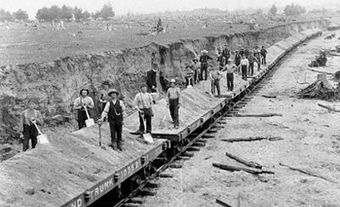Canadian Tire Corporation, Ltd., is one of Canada’s most recognized retail chains. Founded in Toronto by brothers J.W. and A.J. Billes, the company got its start when the brothers bought the Hamilton Tire and Garage in 1922. In 1927, they incorporated the business as the Canadian Tire Corporation. Still headquartered in Toronto, the company operates a network of 1,711 stores and gas bars that extends to every province and territory except Nunavut. Canadian Tire owns Mark’s Work Wearhouse, Helly Hansen and FGL Sports, including the retail companies Sport Chek, Atmosphere and Sports Experts. It is a public company that trades on the Toronto Stock Exchange under the symbol CTC. In 2021, Canadian Tire registered $16.3 billion in revenue and $1.26 billion in net income and held $21.8 billion in assets.

Canadian Tire Incorporates: 1927
Canadian Tire Corporation was launched by John William (J.W.) and Alfred Jackson (A.J.) Billes in 1922, when the two brothers purchased the Hamilton Tire and Garage Ltd., located in Toronto’s Riverdale neighbourhood. The pair bought the business for $1,800. The automotive market was growing; in 1927, Canada had the third highest car ownership per capita in the world. However, the brothers faced an initial challenge when the Gerrard Street bridge across Toronto’s Don River, near which their garage was located, closed for repairs. In order to have better access to their customers, by 1923 the brothers had relocated their garage to a location at Yonge and Gould. There they primarily serviced Fords and Chevrolets. The pair offered one-year unconditional guarantees on tires, a very popular choice in an era when tire blowouts were common. The importance of tires to their business was formalized when they incorporated as Canadian Tire Corporation, Ltd., in 1927. A.J. later recalled that they picked the name because it “sounded big.” Eldest brother J.W. assumed the role of president, A.J. vice-president.

The selection of the name Canadian Tire, along with their successful guarantee on tires, was emblematic of the Billes’s strong understanding of marketing and customer relations. They sought to fulfil the ambition of their nation-spanning name by launching a mail-order catalogue in 1928. The catalogues contained road maps, along with price lists for prospective customers. The company’s mail-order business largely found clients through Ontario and into the Maritimes. Their store was plastered with memorable slogans and images promoting their “Super-Lastic” tires at prices that generally undercut other options. They also purchased car parts from the same manufacturers that built for Ford and GM, undercutting the large car companies for part prices.

Canadian Tire’s focus on repairs and do-it-yourself maintenance served it well during the Great Depression. As car sales dropped, car owners sought new ways to extend the life of their current vehicle. The company branding, emphasising low cost but guaranteed value, drove increased sales. Business was good enough that the company established its first associate dealership with Walker Anderson, who opened a Canadian Tire store in Hamilton in 1934. The company’s associate dealership model, which persists today (with a greatly expanded and more formal contract), allowed dealers to establish and own Canadian Tire stores by agreeing to purchase Canadian Tire-made and -approved products and sell them at their stores. Initially, there was no franchise fee, and the agreement gave considerable operational freedom to individual store owners. Through this, the Billeses made money by having a network of retailers purchasing and marketing their tires, car parts and other wares. This network compelled the Toronto office to relocate to a large building at Yonge Street and Davenport Road (where a Canadian Tire remains today), where clerks famously glided on roller skates to retrieve orders for customers. This dealer model was very successful, and by 1940 there were 105 Canadian Tire locations throughout Ontario and Eastern Canada. The Second World War briefly halted most expansion, since the vital rubber and steel needed for the company supplies were in short supply.
Postwar Years
Toward the end of the war, Canadian Tire looked to expand further. To facilitate this, the company went public in 1944, selling 100,000 shares of stock at ten dollars apiece. This decision to go public was soon followed by A.J.’s development of a profit-sharing scheme with Canadian Tire employees, launched in 1946. Through the plan, the company redirected 10 per cent of employee earnings toward company stock, which could be cashed after ten years or at retirement for considerable profit. A.J’s desire to promote loyalty among employees drove the scheme—at the expense of unionization. His hostility toward unions was made clear when he resisted a company plan to expand into Australia, which he regarded as too heavily unionized.
Following the war, Canadian Tire had expanded its interest beyond automotive parts to promote camping and outdoor leisure items. Just as the Billes brothers successfully caught a growing automotive market, the move toward outdoor and camping supplies aligned with growing business opportunities, since visits to national parks increased from 500,000 to 5.5 million between 1940 and 1960, and the popularity of backyard leisure activities such as barbecuing grew with the suburbs. The company continued to enjoy strong returns, and demand for products led to the construction of a new 225,000-square-foot warehouse in north Toronto in 1956. The next year, the company issued its first French-language catalogue, reflecting its expanding geographic reach.
Amidst this growth, the company’s cofounder and first president, J.W. Billes, died in 1956 of complications from pernicious anemia. His estate was valued at approximately $6.2 million. At the time of his death, 150 dealer-owned stores stretched from Ontario to Atlantic Canada. His will bequeathed the vast majority of his voting shares in trusts to charities and to the University of Toronto. This decision, which took stock off the open market, made it difficult for either A.J. or J.W.’s son, Dick, to take a controlling share of the company. The will and unclear succession plan contributed to widening the rift between A.J. and J.W.’s lines of the Billes family. While A.J. succeeded his brother as president, tensions within the company board persisted until Dick quit in 1959 over a dispute about whether Canadian Tire stores should remain open on Boxing Day. Three months later, Dick tried to gain the company board’s support for ousting A.J. but failed.
Despite these struggles, A.J. pressed on in 1958 with an ambitious scheme to open gas bars at various Canadian Tire locations. This was a bold move, since oil companies like Imperial Oil were fiercely competitive and were recently enriched by oil discoveries in Alberta. To compete, also in 1958 Canadian Tire began issuing “money” that entitled gas customers to an in-store rebate. By 1961, the company commissioned the British American Bank Note Company, which printed the official Canadian government notes, to print Canadian Tire money, giving the notes considerable marketing appeal. The dealers initially opposed the idea, fearing it would cut into individual store profits. However, the money’s popularity amongst customers undercut their concerns. According to the company history, the marketing idea was developed by Muriel Billes (A.J.’s wife). However, divisions within the Billes family contribute to an internal dispute over whether or not Muriel actually developed the idea.
New President: Dean Muncaster
Once A.J. Billes cemented his hold as president of the company he cofounded, he began looking for successors. He gave direct control of the Canadian Tire flagship store at Yonge and Davenport to his eldest son, Fred, but he also began searching outside the family for a new leader. By 1964, A.J.’s doctors insisted that he step down as president, since his constant workload strained his health at age 62. He and the board eventually decided on Joseph Dean Muncaster, who had several advantages: his father was the dealer of the Sudbury Canadian Tire, a successful store; he was part of a new generation of managers with an MBA; and he had been working in Canadian Tire’s head offices since he was 24. In anticipation of the transition, Muncaster had been promoted to vice president in 1963 and formally took over as president in 1966.
Muncaster launched three key initiatives. First, he modernized the company’s managerial structure, creating several new senior manager positions. Gone were the days when a new dealer might acquire a Canadian Tire store with a simple handshake and an agreement to buy Canadian Tire products. Second, Muncaster looked west, as Canadian Tire had no presence west of Ontario. By the end of 1966, the company opened a store in Winnipeg. Muncaster also oversaw an expansion of the company’s warehouse and shipping capacity, which enabled the firm to expand into home décor. Finally, he brought in one of the first IBM computer systems in Canada to help streamline inventory management across the growing organization. These initiatives centralized control over the dealers; Muncaster’s management team proved willing to remove dealers who underperformed as per their new computerized metrics, and higher expectations for product turnover were enforced.
For the most part, the Muncaster-led expansion was successful. Profits increased from $3.6 million when he took over in 1966 to $25 million by 1975, and by 1980 Canadian Tire’s 333 stores had expanded all the way to British Columbia. However, not everything went well during the 1970s, when rates of both inflation and unemployment were high; by 1977, the company reported its first ever year with no profit, and concerns about oversupply and overexpansion grew.
Ownership Disputes
During the 1980s, the long-simmering disputes between the Billes family members erupted. In 1980, A.J. finally resigned from the company board when his wife Muriel passed, appointing his daughter, Martha. Rifts also began to emerge between the Billes family and Muncaster, namely over his expansion plans in Australia, A.J.’s desire to further expand profit-sharing and flattening returns on investment. The divided situation became more complicated when the various charitable organizations that held the trust shares that had been bequeathed by J.W. back in 1956 sought to sell. Imasco, the British American Tobacco-held company that owned Shoppers Drug Mart, immediately offered to buy all shares of Canadian Tire for $1.1 billion. Imasco was encouraged by interest from Muncaster and the Canadian Tire management team but faced stiff resistance from A.J and his children. The ferocity of family resistance eventually led Imasco to drop its bid, further weakening Muncaster’s position. Following Imasco’s departure, A.J.’s three children, Martha, Fred and David, won the bid on the shares from the charitable trusts, meaning they now held 60.9 per cent of voting shares. Following a highly unprofitable purchase of the Texas retail chain Whites, Muncaster was ousted as president in 1984. He was eventually replaced by Dean Groussman, the company’s first American president.
However, ownership uncertainty remained, as Martha, Fred and David Billes, who had a famously tumultuous relationship, continued to jockey for control of the company shares. The dealers also sought to increase their power. In 1986, a united front of 361 store dealers offered a bid to the siblings for $160 a voting share, four times the market value. If successful, the dealers would acquire a majority share of the firm. The bid caught the attention of the Ontario Securities Commission, which alleged that the deal did not consider the interest of shareholders with nonvoting shares, who would not benefit from the high price for voting shares. The affair pitted Fred and David, who wanted to sell, against Martha, who didn’t. After the OSC quashed the dealer bid, the siblings took their dispute to court. Finally, in October 1989, an agreement was reached between the siblings and the dealers whereby no one party could make a sale that would threaten their majority hold without first informing the other parties and giving them first opportunity to bid.
Despite the widely reported ownership disputes, the company began to recover from its difficulties following the Whites acquisition. The company ran several successful advertisement campaigns, and in 1986 the firm reported profits. In 1997, the Billes disputes ended at last when Martha Billes bought out her two brothers’ holdings.
21st Century
Canadian Tire has undertaken several initiatives in its effort to remain competitive, particularly with the expansion of US-based chains like Walmart and Home Depot and growing competition from online retail services. The company homogenized the layout of Canadian Tire stores, using clearly delineated sections and providing information kiosks. In 2001, Canadian Tire underwent a friendly merger with Calgary-based Mark’s Work Wearhouse, diversifying its market position. Building on its experience with Canadian Tire money, the company expanded its financial services arm, launching the Canadian Tire Bank in 2003. The bank was meant primarily to market a credit card linked to Canadian Tire money. It has also continued to expand its product and brand offerings. To capture more of the youth market, Canadian Tire took over Forzani Group (owner of Sport Chek and other athletic stores) in 2011. It acquired Norway-based sportswear company Helly Hansen in 2018. Seeking more of the millennial market, it acquired Party City’s Canadian stores in 2019.
In recent years, Canadian Tire has focused on its online store, recalling its catalogue roots that took it from Toronto to the entire country. In 2021, Canadian Tire registered 2.1 billion in e-commerce sales.
Canadian Tire’s current CEO is Greg Hicks, who previously ran Canadian Tire’s retail arm.

 Share on Facebook
Share on Facebook Share on X
Share on X Share by Email
Share by Email Share on Google Classroom
Share on Google Classroom









